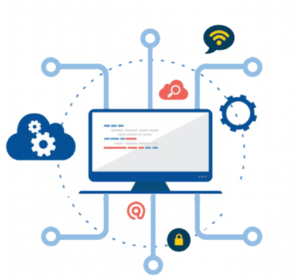In 2020, Low Code Application Platform (LCAP) became an essential part of any enterprise technology service. Particularly during the Covid-19 pandemic, organizations everywhere have been trying to prioritize the ability to transform and modernize to meet the growing expectations of their customers for a seamless digital experience and to remain competitive. Many of them are facing the challenges to equip their teams with the tools which enable their employees to extract the most value from data, improve process efficiency, reduce manual work, and increase overall speed. Fortunately, Enterprise Low-code is the next big step to work with customers, partners, or internal colleagues.
1. What are the challenges that most businesses are struggling with?
The challenges could be boiled down to five main obstacles:
- Lack of network performance – IT developers are overloaded with workloads and don’t have the capacity to keep up with internal demand for custom applications.
- Insufficient budget – Individual teams and departments usually cannot afford to buy necessary apps or to have experts to create the tools they need.
- Outfashioned systems – Although there is an obvious need to modernize outdated systems, untangling them from business processes and replacing them with agile digital systems is disruptive and expensive.
- Differences in skills – Non-technical business users (citizen employees) lack the knowledge and experience required to build the code-intensive apps they need in their daily workflows.
- Demand for speed – Even with effective DevOps in place, the speed of development itself is often slow because of its complexity. Therefore, maximizing developer productivity amid the rising demand for enterprise applications is a major challenge.

Five main obstacles that most businesses are struggling
2. So, what does Enterprise Low Code Platform look like, and how can it help to deal with those challenges?
Gartner defines low-code application platforms (LCAPs) as “an application platform that supports rapid application development, deployment, execution, and management using declarative, high-level programming abstractions like model-driven and metadata-based programming languages, and one-step deployments. LCAPS provides and supports user interfaces, data services, and business processes.”
In this digital era, application development has exploded and the demand for developers is higher than ever as new services and new digital journeys are being created. However, the availability cannot continue with the demand. Developers are expensive and specialized resources so developer efforts need to be focused. Low Code Automation is key to finding a new way. It is a software development approach that permits the delivery of applications faster and with minimal hand-coding. For developers, low code automation tools allow them to work faster and more efficiently by skipping hand-coding, speeding up the process of getting an application to production. For non-developers, it gives them the authority to build, alter, and use enterprise apps that fulfill emerging needs almost as soon as that need arises. Therefore, the low code development platform enables organizations to face emerging needs with speed and agility. They help organizations solve business problems, support team collaboration and productivity, achieve business objectives, and develop a mature digital ecosystem to achieve a competitive edge.
Low-code follows the trend on how people interact with systems – from mobile, desktop and laptop into new forms of interactions:
- Conversational
- Voice
- Augmented reality
- Wearable devices

Low-code follows the trend on how people interact with systems
All brought together as a multi-experience. Not just additional channels, but users communicating simultaneously through channels, switching back and forth, with a backend system that’s always there, doing things on their behalf. This really demands a replacement way for approaching the user journey.
According to Gartner, indeed, by 2024, three out of 4 huge enterprises will be employing a minimum of 4 low code development tools to enhance IT application development and citizen development initiatives. By the same time, low-code application development will account for more than 65% of all app development activity.
And these days, all low code software can utilize services to connect to other applications and functionality. An enterprise low code platform not only provides its own set of platform services supporting varying types of critical functionality but these low code platform services are also designed to work with the platform’s modeling engine to dynamically provide parameters on how the functionality should be used for different business situations.
3. Let’s go over a few examples:
3.1. Marketing
Successful marketing requests high-level data analytics, rapid delivery, and constant experimentation.
Low code platforms that help marketers reduce reliance on IT will ultimately give them the power to gain the level of speed and customization they’re after. For example, low code platforms that allow them to plan, run, and track cross-channel marketing campaigns — with all the expected workflows and reporting — will empower them to become more self-sufficient and effective in chasing their goals.
3.2. Enterprise application integration and automation
As employees’ digital toolbox continues to expand, a number of the latest technological, business, and user challenges have arisen.
Integrating a high volume of complex and disparate systems may be a major technical challenge. And while businesses realize the importance to equip employees with emerging digital capabilities, they often overlook how the abundance of tools can actually detract from productivity and contribute to fatigue.

Enterprise application integration
For example, with an answer that permits seamless integration, IT will not have to manage accounts and allowances in multiple systems for every employee who needs access, because you can deliver this capability through one integrated app. Gaining this capability via low-code application development reduces a heavy burden on IT and allows them to focus their expertise on more demanding tasks.
4. Conclusion
Enterprise low code technology enables organizations to beat the standard obstacles in obtaining enterprise applications and satisfying unique needs. Departments throughout the organization have the potential to develop, test, and use apps without counting on IT. Therefore many companies are now exploring this future of work – Enterprise low code. However, low-code tools aren’t really as new solutions as you think. They have been around and grown rapidly for decades and, with every re-emergence, the expectations are high. So your organizations need to choose a good enterprise low code platform. In order to do so, keep in mind these few considerations: Clarify what you want low-code to do for you; Identify the right people to use the platform; Expect IT to still be involved; And a little complexity, which you can prepare for.
We hope you enjoy reading this blog post.
If you want my team at Kyanon Digital to help you apply enterprise low code effectively, just book a call.
For more information about low-code platform. Download the white paper here.


